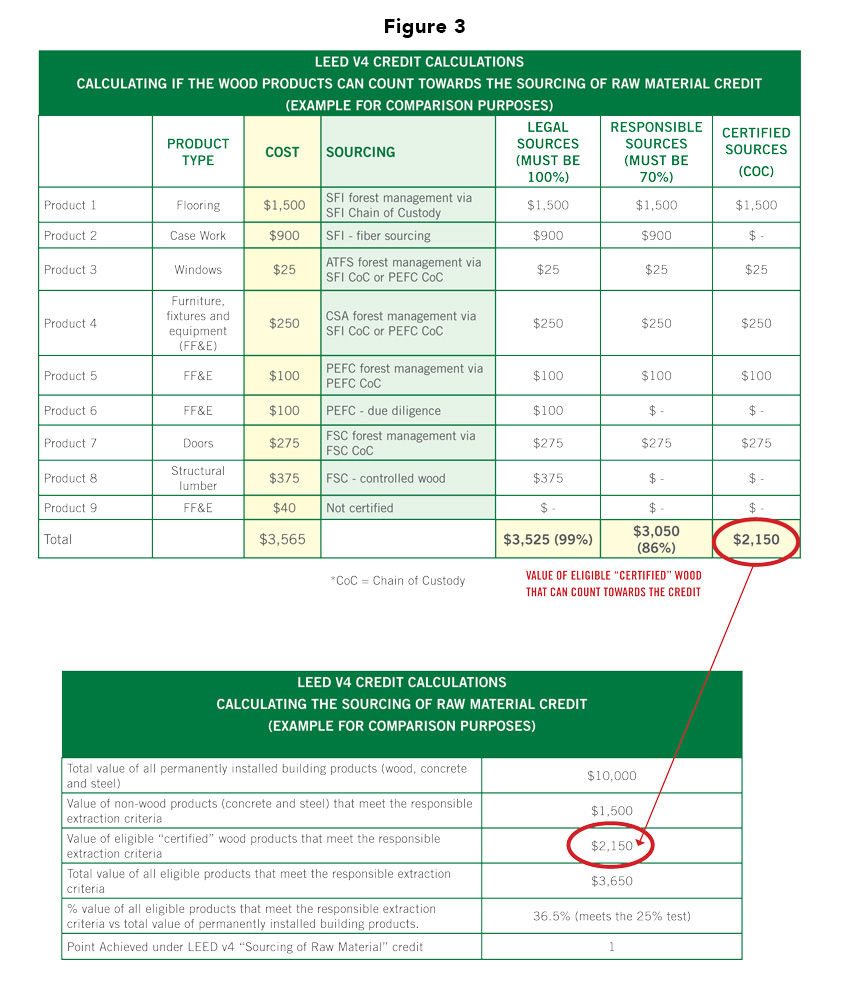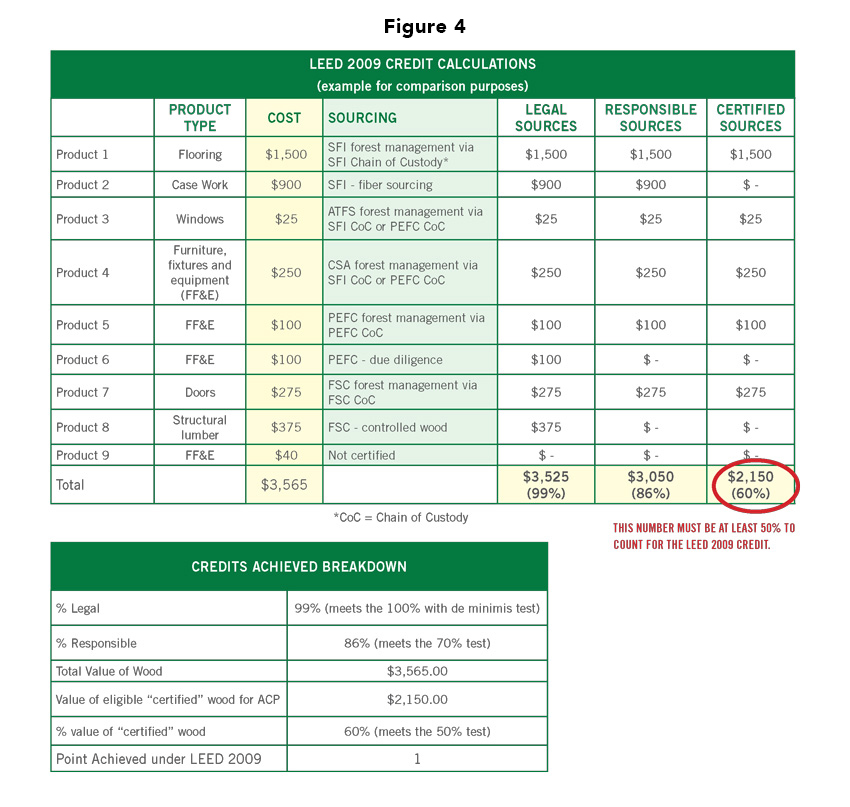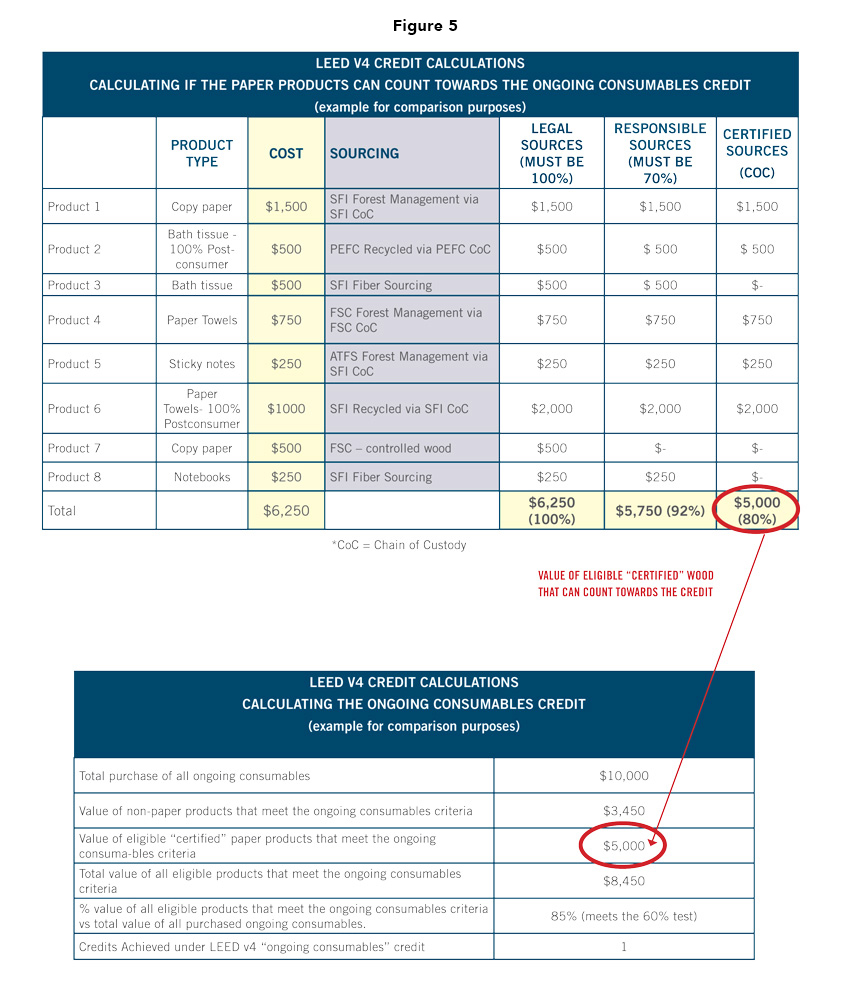Creating a New Path for Forest Products In Green Buildings
How to Count Certified Products for a LEED Point
USGBC released LEED v4 in the summer of 2013, and it will eventually replace LEED 2009. However, builders, architects, and/or building operators can still submit projects under LEED 2009 if they register their projects by October 31, 2016. If the projects are registered on or before this date, the builders, architects, and/or building operators have until June 30, 2021 to complete their projects under LEED 2009. LEED v4 takes a more holistic approach than the LEED 2009 rating tool and focuses on all building materials to get a better understanding of the effect those materials have on the environment. Figures 3–5 highlight the various categories under the new ACP and what counts toward the credit. It’s important to note that LEED v4 and LEED 2009 use different accounting methods, which are discussed in detail below.
To help with determining if a product meets the new ACP, USGBC has published a credit calculator (www.usgbc.org/resources/legal-wood-pilot-acp-calculator) that shows what forest certification standards count toward the various categories as defined by ASTM D7612-10 (2015).
LEED v4 Using BD+C as an Example
In order to qualify for a point under the “sourcing of raw materials” credit in LEED v4 BD+C, a builder or architect must use at least 25 percent (based on cost) of permanently installed building materials that meet at least one of the responsible extraction criteria below.
- Extended producer responsibility (EPR): These are products purchased from a manufacturer that participates in an EPR program or is directly responsible for EPR. Extended producer responsibility uses financial incentives to encourage manufacturers to design environmentally friendly products by holding producers responsible for the costs of managing their products at end of life.
- Bio-based materials: Bio-based products must meet the Sustainable Agriculture Network’s Sustainable Agriculture Standard. Bio-based raw materials must also be tested using ASTM Test Method D6866 and be legally harvested.
- Reused materials and recycled content: “Reused” includes salvaged, refurbished, or reused products, and recycled content is calculated as the sum of post-consumer recycled content plus one-half the pre- consumer recycled content.
- Wood products: Wood products sourced from “certified” sources as defined by ASTM D7612-10 (2015) are deemed to satisfy the requirements of this credit.
For purposes of using SFI products, a builder or architect can use wood products certified to SFI under the “wood products” criterion to achieve a point under LEED v4. The builder or architect must first know that:
- 100 percent (with a de minimis amount) of all wood used on the project is from legal (non-controversial) sources; and
- 70 percent of all wood used on the project is from responsible sources.
- Once the above two criteria are satisfied, CoC certification can satisfy the final requirement that: at least 25 percent (based on cost) of all permanently installed building materials meet a responsible extraction criterion in LEED v4 rating tools.
To calculate an example, if the total value of all permanently installed building products (wood, concrete, and steel) is $10,000, the builder or architect must use at least $2,500 (25 percent of the total value) worth of materials that meet one of the four responsible extraction criteria. Figure 3 offers an example of how this credit might be calculated.

Source: SFI Inc.
LEED 2009 Using BD+C as an Example
LEED users must meet several criteria in order to qualify for a point under the new ACP in LEED 2009. They must first know that:
- 100 percent (with a de minimis amount) of all wood used on the project is from legal (non-controversial) sources; and
- 70 percent of all wood used on the project is from responsible sources.
- Once the above two criteria are satisfied, CoC certification can satisfy the final requirement that: at least 50 percent (based on cost) of wood-based materials are certified.
Figure 4 offers an example of how this credit might be calculated.

Source: SFI Inc.
LEED v4 Using O+M as an Example
The ACP also applies to LEED for Existing Buildings: Operations and Maintenance. This means that using paper, tissue,or furniture products certified to SFI Standards can help building operators achieve points in LEED v4 and LEED 2009. Below is an example of how to source SFI paper products to achieve a point in the ongoing purchasing of consumables credit.
In order to qualify for a credit under the “purchasing – ongoing” credit in LEED v4, a building must purchase at least 60 percent, by cost, of total ongoing consumables that meet at least one of the following criteria. Each purchase can receive credit for each criterion met.
- Post-consumer recycled content: The content of purchases must meet or exceed the levels listed in the U.S. Environmental Protection Agency Comprehensive Procurement Guidelines.
- Extended use: Batteries must be rechargeable. Toner cartridges for laser printers must be remanufactured.
- Sustainable agriculture: Food and beverages must be labeled USDA Organic, Food Alliance Certified, Rainforest Alliance Certified, Protected Harvest Certified, Fair Trade, or Marine Stewardship Council’s Blue Eco-Label, Canada Organic logo in accordance with Organic Products Regulations (SOR/2009-176) or labeled with the European Community Organic Production logo in accordance with Regulations (EC) No. 834/2007 and (EC) No. 889/2008.
- Local sourcing of food and beverages: The food or beverage must contain raw materials harvested and produced within 100 miles (160 kilometers) of the site.
- Bio-based materials: Bio-based products must meet the Sustainable Agriculture Network’s Sustainable Agriculture Standard. Bio-based raw materials must be tested using ASTM Test Method D6866 and be legally harvested, as defined by the exporting and receiving country. Exclude hide products, such as leather and other animal skin material.
- Paper and wood products: Paper and wood products must be sourced from “certified” sources as defined by ASTM D7612-10 (2015)
For purposes of SFI recognition, paper products certified to the SFI Standard under the “paper and wood products” criteria contribute to the 60 percent, by cost, of total ongoing consumables to earn a point under LEED v4. The owner or operator must first know that:
- 100 percent (with a de minimis amount) of all paper purchased for the building is from legal (non-controversial) sources; and
- 70 percent of all paper purchased for the building is from responsible sources.
- Once the above two criteria are met, the owner or operator must purchase paper from certified sources through a CoC. This can then count toward the final requirement that: at least 60 percent (based on cost) of all purchased total ongoing consumables meet at least one of the ongoing consumables criteria listed above.
To calculate an example, if the total spend for ongoing consumables is $10,000, the owner or operator must buy at least $6,000 (60 percent of the total value) worth of ongoing consumables that meet at least one of the six ongoing consumables criteria.
Figure 5 offers an example of how this credit might be calculated.

Source: SFI Inc.









